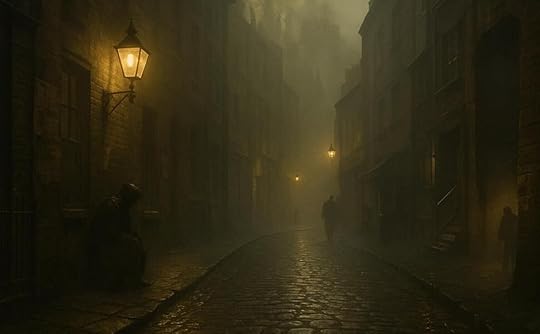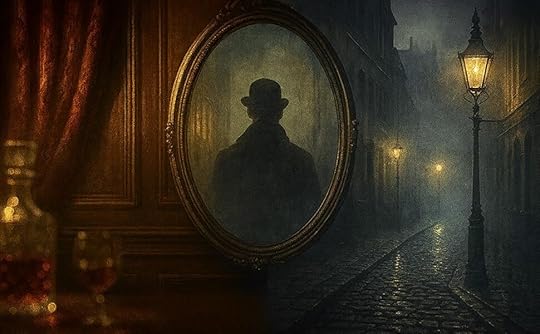KEVIN MORRIS’ UNHOLY MISSION TO RESURRECT JACK THE RIPPER — IN AN ELECTRIFYING VICTORIAN GOTHIC MURDER MYSTERY

A 3-part Historical Horror sequel dares to ask what happened after the Canonical Five — and answers with a binge-worthy Victorian Crime Thriller
By Gerard Edmund Snook
The autumn of 1888 has been etched into Britain’s collective memory as a season of dread. In scarcely three months, five women were brutally murdered in London’s East End. Then, as if swallowed by the fog he prowled, the killer vanished. No confession. No conviction. Only a vacuum where an ending ought to be.
That absence — the unsolved chord that never resolves — is the ignition point for No Rest for the Damned, Kevin Morris’s bold, 3-part Historical Murder Mystery. Rather than re-stage the crimes, Morris pivots hard into a Victorian Detective Mystery of aftermath and reckoning. It’s a premise with the snap of great television: what if the story truly begins after the Canonical Five?
Morris, founder of indie imprint Trilogies of Terror, talks us through the artistic gamble of writing a sequel to history — one that leans into Victorian Gothic atmosphere, Whitechapel Police Procedural grit, and the propulsive tempo of modern serial storytelling.
“WHY WE’RE STILL OBSESSED”
GES: It’s been over 135 years since the last known attack. Why does the case keep its grip on us?
KM: Jack the Ripper sits in the realm of Victorian mythology now. The savagery of the scenes, the speed of the killings, the complete absence of closure — it all fuels speculation. Because we never had a definitive name or a courtroom finale, the case invites readers and viewers to become detectives. That tension between horror and hypothesis is evergreen.
A SEQUEL TO THE OFFICIAL STORY
GES: The book takes a striking approach: rather than retell the murders, you write the sequel. Why?
KM: The case has been dramatised countless times — from Murder by Decree to From Hell — and there are excellent Victorian Gothic retellings out there. We weren’t interested in mounting the same scaffold and promising a different twist. We wanted the narrative electricity of What next? A story that honours the historical record and then steps past its boundary to imagine the consequences.
HORROR FICTION VS HISTORICAL FACT
GES: Is your premise something that could have happened?
KM: Some elements align with known details — that’s inevitable when you live in the archives for long enough — but plausibility wasn’t the prime directive. Authenticity of feel was. We built a Victorian London Noir where the choices, stakes and institutions ring true, even as the plot strides into uncharted territory.

INSIDE “DARKEST LONDON”
GES: What did your research illuminate about Whitechapel?
KM: Why it worked for the killer. The East End was dubbed “Darkest London” for a reason. Soot-blackened masonry, factory smoke that smothered moonlight, gas lamps reduced to halos. Poverty forced hard choices; women risked shadowed corners for a night’s shelter or a dram. In that maze, a murderer could operate quickly and disappear just as fast. The police had suspects, yes, but few clean leads, and consensus on identity remains elusive even now.
THE GENTLEMAN KILLER IMAGE
GES: The top hat, cape, and bag — the gentleman silhouette is everywhere. Did that affect your portrayal?
KM: It’s become the costume we mentally dress the culprit in, even though it’s largely an invention. The risk with myth is that anything that contradicts it feels untrue. We chose to stay faithful to a contemporary profile of a serial offender rather than to the silhouette. The unfamiliar is more unsettling than the familiar — and that deepens suspense.

SKIPPING THE CONSPIRACIES
GES: Freemasons, Prince Albert Victor, Sir William Gull — the theories persist. Do you engage with them?
KM: Not directly. No Rest for the Damned is a fictional continuation of accepted facts, not a compendium of the most popular suspects. We acknowledge the noise, but we don’t retread it. This is a fresh investigation that begins where the official account ends.
HOW THE SEQUEL CONNECTS
GES: How do you maintain continuity with the historical record?
KM: We open in the immediate wake of the fifth victim’s discovery and follow through to the funeral — a moment of collective grief that anchors the reader in time and place. The Canonical Five are not merely names; they cast a long shadow over every decision our protagonists make. We also introduce a vital new lead tied to one of those victims, threading past and present. Familiar figures — Superintendent Donald Swanson, Inspector Frederick Abberline — are dramatised as living, conflicted men rather than footnotes, grounding the fiction in recognisable history.
INFLUENCES AND INTENT
GES: What stories shaped your approach?
KM: We drew from the fiction we love: The Alienist by Caleb Carr, Alex Grecian's The Yard, and the classic Victorian Gothic canon — Dracula, Dr Jekyll and Mr Hyde. We were also inspired by serialised television — The Alienist and The Angel of Darkness in particular — to design a reading experience with that same episode-to-episode momentum. Ten short, taut instalments that stand alone but combine into a larger, more ominous whole.
THE TEN-PART ENGINE
GES: How do you sustain tension across ten entries, over three books?
KM: End on a hinge. Each part concludes at a point of decision or discovery — not a cheap fake-out, but a moment that demands the next step. You keep the reader’s foot off the brake by ensuring the emotional stakes rise alongside the investigative ones.
WHAT YOU’RE GETTING:
A Victorian Crime Thriller that treats Whitechapel as a living crime scene rather than a museum piece.
A Historical Murder Mystery that privileges human motive over baroque conspiracy.
A Victorian Detective Mystery with Abberline and Swanson caught between public pressure and private doubt.
Atmosphere for days: soot, fog, alleyways — the full Victorian London Noir palette.
THE LAST WORD
With No Rest for the Damned, Kevin Morris doesn’t promise the one true face of Jack the Ripper. He promises something rarer: a narrative reckoning that feels earned. By resisting the urge to re-enact and instead exploring what comes after, his series finds fresh oxygen in a story we thought we knew. The result is a lean, cinematic page-turner — a Victorian Gothic pursuit that grips like a hand at your sleeve and doesn’t let go.
No Rest for the Damned, Books One, Two, and Three, are available now and FREE on Kindle Unlimited.
Follow Trilogies of Terror and Kevin Morris on Amazon to stay up to speed on new releases and forthcoming instalments in this dark, addictive Whitechapel Mystery cycle.
Published on September 22, 2025 19:15
•
Tags:
historical-murder-mystery, kindle-unlimited, london-gothic-noir, ripper-fiction, victorian-crime-thriller, victorian-gothic-murder-mystery, whitechapel-police-procedural
No comments have been added yet.



